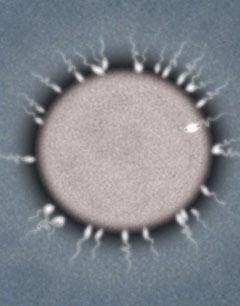Male mice breathing city air carry more mutations.

Don't breath the air: it might meddle with your reproduction
GETTY
Air pollution can cause DNA mutations in the
sperm of mice reared in an industrial city, researchers have found. The
results add to ongoing concerns about the effects of air pollution on human
health and fertility.
The mice, reared in cages kept in a shed downwind
of two steel mills and a busy highway in a Canadian city, showed a host
of genetic changes compared to similarly housed mice breathing filtered
air. DNA in the sperm of the mice in the polluted area contained 60% more
mutations, had more strand breaks, and had more bases that had been chemically
modified via the addition of a methyl group. That modification, called
DNA methylation, can affect whether a gene is expressed.
All of these changes could, in theory, alter
gene expression and function in offspring of these mice, but that has not
yet been directly tested.
"It's important to move this forward to
the next step: determining whether there are any human corollaries to this,"
says Jonathan Samet, an epidemiologist at the Bloomberg School of Public
Health at Johns Hopkins University in Baltimore, Maryland.
Heavy breathing
Air pollution has been linked to respiratory
and cardiovascular difficulties, developmental defects and lung cancer
in humans. But researchers have only begun to tackle the effect of pollution
on sperm.
"There has been work on the reproductive
effects of pollution, but that has largely focused on outcomes of pregnancy,
not on male effects," says Samet.
Epidemiological studies in humans have suggested
a link between air pollution and reduced male fertility, but such studies
are often confounded by other lifestyle differences such as diet, genetic
background, and economic class. No such research has been done on people
in Hamilton Harbour, Canada, where the mouse studies were carried out. |
Previous work had demonstrated that the offspring
of wild birds that breed near steel mills inherit more DNA mutations than
their rural counterparts. Then, studies in mice suggested a possible reason
for that pattern. Canadian researchers found that filtering out particles
from polluted air lessened the risk of heritable mutations in mice caged
near Hamilton[1]. And the bulk of mutations from pollution were coming
from the father[2].
Now, in work published this week in the Proceedings
of the National Academy of Sciences USA[3], Carole Yauk of Health Canada
in Ottawa and her colleagues have returned to Hamilton. This time they
monitored male mice for direct evidence of DNA damage in their sperm.
Heavy damage
After three weeks of breathing the Hamilton
air, the mice were already showing more signs of DNA breakage than control
mice breathing filtered air. At 10 weeks, their DNA was significantly more
methylated than controls. And 16 weeks after the experiment began, their
DNA contained more mutations at a specific site than the controls.
Precisely how the pollution caused the DNA
damage remains unclear. "It's quite a leap to go from a lungful of air
to damaging germ cells in the testes of these mice," says Christopher
Somers, a biologist at the University of Regina in Saskatchewan and an
author on the study.
The researchers also tested the DNA for signs
of direct mutagenesis by a class of chemical compounds called polycyclic
aromatic hydrocarbons. Although these compounds are known to cause mutations
and are enriched in the Hamilton air, there were no signs that they were
responsible for the damage.
That could mean that the changes may be a
more general response to particulate pollution, says Somers. For instance,
metals bound to the particulates can favour the production of chemically
reactive forms of oxygen called reactive oxygen species.
"If that's the mechanism, you might think
that it has general applicability to other sources of pollution, not just
steel mills," says Samet.
References
1. Somers, C. M. ,
McCarry, B. E. , Malek, F. & Quinn, J. S. Science 304, 1008–1010
(2004).
2. Somers, C.M. et
al. Proc. Natl Acad. Sci. USA 99, 15904-15907 (2002)
3. Yauk, C. et al.
Proc. Natl Acad. Sci. USA 105, 605-610 (2008). |